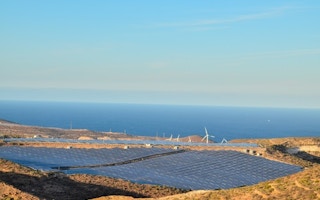It probably surprises nobody to learn that coal produces more of the world’s electricity than any other fuel. But it may provide food for thought to realise that the second most widely-used fuels for power generation are now renewables.
Electricity generation from renewable sources has overtaken natural gas to become the second largest source of electricity worldwide, the International Energy Agency (IEA) has announced.
In Europe, the main renewables used to generate electricity are wind and solar power. Since 1990, global solar photovoltaic power has been increasing at an average growth rate of 44.6 per cent a year, and wind at 27.1 per cent.
The IEA reports that electricity production last year in the 34 members of the Organisation for Economic Co-operation and Development (OECD) fell slightly to 10,712 TWh (terawatt hours) ̶ a decrease of 0.8 per cent (86 TWh) compared with 2013. To put that in context, 1 TWh is 1 billion kilowatt hours, and each KWh takes about 0.36 kilograms of coal to generate.
“
By 2040, the world’s energy supply mix is likely to divide into four almost-equal parts: oil, gas, coal and low-carbon sources.
Partially offset
This decline, the agency says, was driven by lower fossil fuel and hydro production, which were only partially offset by increases in non-hydro renewables. These grew by 8.5 per cent, and nuclear energy by 0.9 per cent.
In 2014, solar photovoltaic power overtook solid biofuels ̶ used in power plants that burn biomass ̶ to become the second-largest source of non-hydro renewable electricity in OECD countries of Europe, with a share of 17.3 per cent.
The IEA says overall growth in electricity generation continues to be driven by non-OECD countries. Its latest statistics, which show world electricity generation increasing by 2.9 per cent between 2012 and 2013, reveal two distinct trends.
Electricity generation is levelling off within the OECD, while it is rising strongly in the rest of the world. In 2011, non-OECD countries for the first time produced more electricity than members of the OECD.
Other milestones were reached in 2013, when global non-hydro renewable electricity exceeded oil-fired generation for the first time, and renewable electricity overtook natural gas to become the world’s second largest source of electricity, producing 22 per cent of the total.
In the same year, electricity generated by coal reached its highest level yet at 9,613 TWh, representing 41.1 per cent of global electricity production. The growth in coal generation was driven by non-OECD countries.
Globally, more renewable energy is consumed in the residential, commercial and public services sectors than elsewhere, but there are two distinct patterns of use.
In non-OECD countries, only 22.3 per cent of renewables are used for electricity and heat production and 60.7 per cent in homes, commercial and public sectors. In OECD countries, more than half of the renewable primary energy supply (58.5 per cent) is used for electricity and heat.
Huge challenge
The IEA’s data will encourage renewable energy’s supporters, but they also show how much the world continues to rely on fossil fuels for its electricity.
In 1971, coal produced about 2 TWh of global electrical power, but that figure is now almost five times higher. Replacing that much generation with clean fuels will be a huge challenge, despite the very rapidly accelerating growth of renewables.
Fatih Birol, the IEA’s director, has said that, without clear direction from the UN climate summit to be held in Paris in December, “the world is set for warming well beyond the 2°C goal” ̶ the internationally-agreed limit for global temperature rise that is intended to prevent climate change reaching dangerous levels.
The IEA World Energy Outlook 2014 said that, by 2040, the world’s energy supply mix is likely to divide into four almost-equal parts: oil, gas, coal and low-carbon sources.
This scenario, it said, “puts the world on a path consistent with a long-term global average temperature increase of 3.6°C”.










